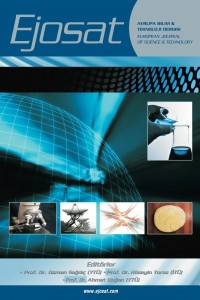Determination of the Establishment Places by Minimizing the Costs of Electronic Waste (E-Waste) Recycling Centers
Abstract
With the technological advances, the desire of the users to renew their existing technologies is increasing rapidly and a new one is added to the old electronic devices every day. Each new product, which incorporates the latest opportunities offered by the technology and puts the old products on the shelf, confronts us with the fact of electronic waste (e-waste) created by the information age. While the new products emerging with the advancing technology increase, the products used by the consumers turn into electronic waste while they are in use. In the world, the solid waste problem is mostly faced by the electricity and electronics industry because products are getting obsolete and scraped in this industry. E-waste threatens the human and environment in terms of quantity and active substance they contain when they are disposed of. Nowadays, it is important to recycle electronic waste without damaging nature and to recover it with the right methods in creating new products. In this study which is performed according to the information above, a mathematical model is built that decides to in which of the selected 10 cities should be established recycling centers to meet the wastes collected from the waste collection centers among 38 cities of Turkey. As a result, it is determined that one recycling center should be established in one of the selected cities.
References
- Ahluwalia, P. K., & Nema, A. K. (2011). Capacity planning for electronic waste management facilities under uncertainty: multi-objective multi-time-step model development. Waste Management & Research, 29(7), 694-709.
- Bircan, H., & Kartal, Z. (2003). Doğrusal programlama tekniği ile kapasite planlaması yaklaşımı ve çimento işletmesinde bir uygulaması.
- Bloemhof-Ruwaard, J. M., Salomon, M., & Van Wassenhove, L. N. (1994). On the coordination of product and by-product flows in two-level distribution networks: Model formulations and solution procedures. European Journal of Operational Research, 79(2), 325-339.
- Daniel, S. E., Diakoulaki, D. C., & Pappis, C. P. (1997). Operations research and environmental planning. European journal of operational research, 102(2), 248-263.
- de Oliveira Neto, G. C., Correia, A. d. J. C., & Schroeder, A. M. (2017). Economic and environmental assessment of recycling and reuse of electronic waste: Multiple case studies in Brazil and Switzerland. Resources, Conservation and Recycling, 127, 42-55.
- Kang, H.-Y., & Schoenung, J. M. (2005). Electronic waste recycling: A review of US infrastructure and technology options. Resources, Conservation and Recycling, 45(4), 368-400.
- Khoshand, A., Rahimi, K., Ehteshami, M., & Gharaei, S. (2019). Fuzzy AHP approach for prioritizing electronic waste management options: a case study of Tehran, Iran. Environmental Science and Pollution Research, 26(10), 9649-9660.
- Nie, X., Huang, G. H., & Li, Y. (2009). Capacity planning for waste management systems: an interval fuzzy robust dynamic programming approach. Journal of the Air & Waste Management Association, 59(11), 1317-1330.
- Queiruga, D., Walther, G., Gonzalez-Benito, J., & Spengler, T. (2008). Evaluation of sites for the location of WEEE recycling plants in Spain. Waste management, 28(1), 181-190.
Elektronik Atık (E-Atık) Geri Dönüşüm Merkezlerinin Maliyetlerinin Minimize Edilerek Kuruluş Yerlerinin Belirlenmesi
Abstract
Teknolojik gelişmeler ile kullanıcıların mevcut teknolojilerini yenileme istekleri hızla artarken eski elektronik eşyalara her gün bir yenisi eklenmektedir. Teknolojinin sunduğu son olanakları içinde barındıran ve piyasaya sunulan her yeni ürün, eski ürünleri rafa kaldırarak, bizleri de bilgi çağının ortaya çıkardığı elektronik atık (e-atık) gerçeğiyle yüzleştirmektedir. İlerleyen teknoloji ile ortaya çıkan yeni ürünler artarken tüketicinin kullandığı ürünler daha kullanım aşamasındayken elektronik atığa dönüşmektedir. Dünyada en ciddi katı atık problemi yaşanan sektör elektrik ve elektronik endüstrisidir, çünkü bu endüstride demode olma ve hurda elektronik cihazlar artış göstermektedir. E-atıklar hem miktar açısından hem de içerdikleri etken maddeler açısından atıldıkları zaman insan ve çevreyi tehdit etmektedir. Günümüzde önemli olan elektronik atıkların doğaya zarar vermeden geri dönüşümlerinin sağlanarak yeni ürünler ortaya çıkarmada doğru yöntemlerle geri kazanmaktır. Yukarıdaki bilgiler doğrultusunda yapılan bu çalışmada, Türkiye’deki 38 şehirdeki elektronik atık toplama merkezlerinen gelen atıklar için seçilen 10 şehirden hangilerine geri dönüşüm merkezlerinin kurulmasına karar verecek matematiksel model kurulmuştur. Sonuçta seçilen bir şehire geri dönüşüm merkezi kurulması gerektiği tespit edilmiştir.
References
- Ahluwalia, P. K., & Nema, A. K. (2011). Capacity planning for electronic waste management facilities under uncertainty: multi-objective multi-time-step model development. Waste Management & Research, 29(7), 694-709.
- Bircan, H., & Kartal, Z. (2003). Doğrusal programlama tekniği ile kapasite planlaması yaklaşımı ve çimento işletmesinde bir uygulaması.
- Bloemhof-Ruwaard, J. M., Salomon, M., & Van Wassenhove, L. N. (1994). On the coordination of product and by-product flows in two-level distribution networks: Model formulations and solution procedures. European Journal of Operational Research, 79(2), 325-339.
- Daniel, S. E., Diakoulaki, D. C., & Pappis, C. P. (1997). Operations research and environmental planning. European journal of operational research, 102(2), 248-263.
- de Oliveira Neto, G. C., Correia, A. d. J. C., & Schroeder, A. M. (2017). Economic and environmental assessment of recycling and reuse of electronic waste: Multiple case studies in Brazil and Switzerland. Resources, Conservation and Recycling, 127, 42-55.
- Kang, H.-Y., & Schoenung, J. M. (2005). Electronic waste recycling: A review of US infrastructure and technology options. Resources, Conservation and Recycling, 45(4), 368-400.
- Khoshand, A., Rahimi, K., Ehteshami, M., & Gharaei, S. (2019). Fuzzy AHP approach for prioritizing electronic waste management options: a case study of Tehran, Iran. Environmental Science and Pollution Research, 26(10), 9649-9660.
- Nie, X., Huang, G. H., & Li, Y. (2009). Capacity planning for waste management systems: an interval fuzzy robust dynamic programming approach. Journal of the Air & Waste Management Association, 59(11), 1317-1330.
- Queiruga, D., Walther, G., Gonzalez-Benito, J., & Spengler, T. (2008). Evaluation of sites for the location of WEEE recycling plants in Spain. Waste management, 28(1), 181-190.
Details
| Primary Language | Turkish |
|---|---|
| Subjects | Engineering |
| Journal Section | Articles |
| Authors | |
| Publication Date | April 15, 2020 |
| Published in Issue | Year 2020 Issue: 18 |

